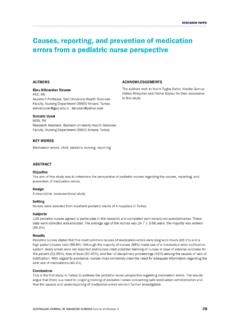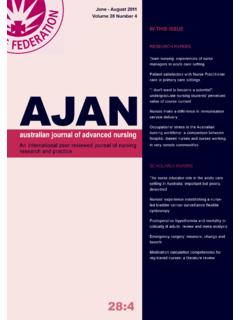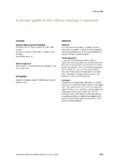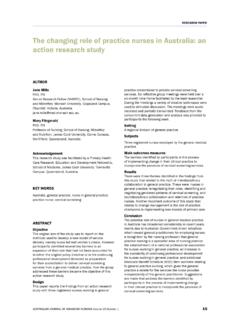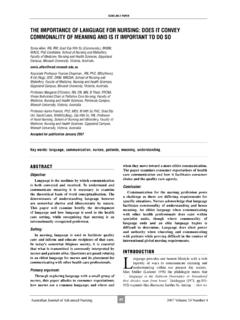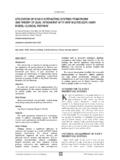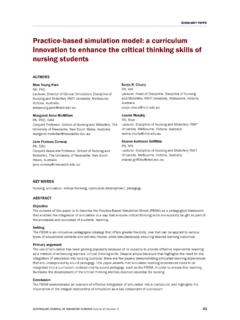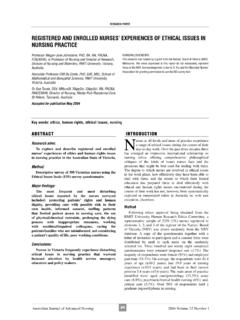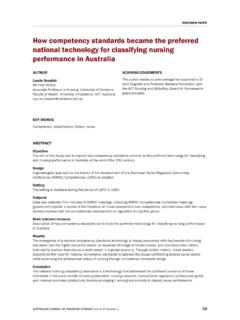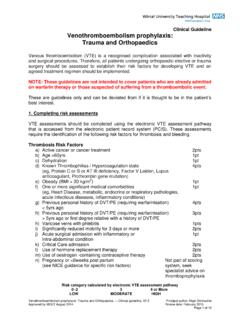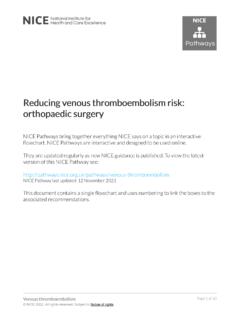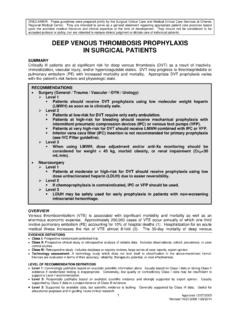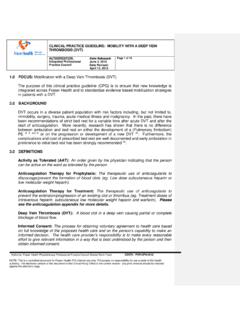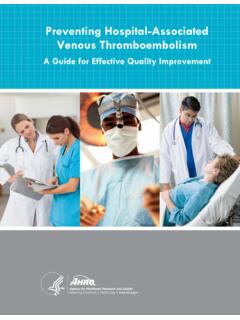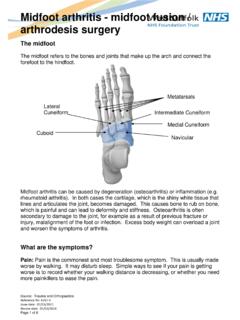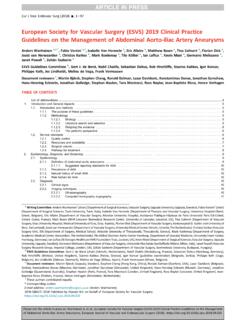Transcription of Venous Thromboembolism Prophylaxis: The role of the nurse ...
1 AUSTRALIAN JOURNAL OF ADVANCED NURSING Volume 27 Number 383 SCHOLARLY PAPERAUTHORSR enea CollinsBN, G Cert Health Management Clinical nurse Consultant (VTE), Princess Alexandra Hospital, Brisbane, Australia. Lorna MacLellanRN, SCM, MN, MNP, G Cert PTT nurse Practitioner Program Convenor, The University of Newcastle, Callaghan, NSW, Australia. Harry Gibbs FRACP Vascular Physician, Princess Alexandra Hospital, Brisbane, Australia. Donald MacLellanFRACS Conjoint Professor of Surgery, The University of Newcastle, Callaghan, NSW, Australia. John FletcherFRACS Professor of Surgery, University of Sydney, Westmead Hospital, Sydney, Australia. KEY WORDSN ursing, Venous Thromboembolism , risk assessment, Thromboembolism prophylaxis : the role of the nurse in changing practice and saving livesABSTRACTB ackgroundVenous Thromboembolism (VTE) predominantly afflicts surgical and medical patients in an acute hospital setting.
2 Responsibility for VTE risk assessment and appropriate prophylaxis to prevent this major health burden rests with a variety of clinical staff. All too frequently, however, patients do not undergo VTE risk assessment on admission. This is regardless of the fact that a number are at risk for VTE, receive no prophylaxis and unknowingly are at risk of serious adverse events including death. ObjectiveThe broad aims of this paper is to provide evidence based information on VTE and to report on the rate of appropriate VTE prophylaxis pre and post nursing educational paper describes a nurse led initiative undertaken at a tertiary level acute care facility in A clinical audit was conducted on 2,063 hospitalised inpatients Primary argumentNurses who are empowered through evidence based education sessions can take responsibility for VTE risk assessment of all admitted patients and ensure appropriate VTE prophylaxis is provided.
3 The rates for appropriate prophylaxis in admitted patients at risk of VTE increased from 27% to 85% (p< ). Through appropriate prophylaxis of patients at risk of VTE, the incidence of VTE will be significantly reduced. ConclusionsNurses who are committed to VTE risk assessment and prophylaxis have the ability to contribute significantly to the reduction of VTE and its subsequent complications. AUSTRALIAN JOURNAL OF ADVANCED NURSING Volume 27 Number 384 SCHOLARLY PAPERINTRODUCTIONVTE is the term that describes two clinical conditions: deep vein thrombosis (DVT) and pulmonary embolism (PE). DVT occurs when a blood clot or thrombus forms in a deep vein, usually restricting blood flow.
4 Pulmonary embolism occurs if the thrombus dislodges and travels to the lungs. Michota (2007) stated that VTE is considered to be the most common preventable cause of hospital related death. Symptomatic VTE is a major health problem. In Australia, it is estimated that VTE will affect approximately 15,000 individuals and be responsible for over 5,000 deaths each year (Access Economics 2008). The financial burden of VTE on the health care system is considerable and is estimated to be as much as $ billion (Access Economics 2008). Symptomatic PE results in sudden death in about 25% of cases (Heit et al 2001). The morbidity associated with DVT is often under recognised and includes serious long term complications such as chronic Venous insufficiency, chronic oedema, chronic pain and recurrent Venous ulceration, collectively known as the post thrombotic syndrome (Kahn 2006; Ziegler et al 2001).
5 As the deaths due to VTE occur before treatment can be instituted and the post thrombotic syndrome occurs in spite of treatment, the only way to prevent these complications is to prevent VTE from occurring. VTE is recognised as having a high risk in a proportion of surgical, medical and obstetric clients in the acute care system with about 50% of all cases of VTE in our community occurring following recent hospitalisation (Heit 2003). It is also a significant risk for the chronically ill in the community and to residents of aged care facilities. Effective prophylaxis using anticoagulants and/or mechanical devices such as compression stockings or intermittent pneumatic compression reduce the development of VTE by about 80% (Collins et al 1988; Clagett and Reisch 1988).
6 The Access Economics Report (2008) also identified that there was lack of a systematic approach to prevent VTE in many Australian hospitals. Internationally and nationally, the assessment of patients who may be at risk is not uniformly undertaken and despite the availability of evidence based guidelines for VTE prophylaxis , many patients receive no prophylaxis (Cohen et al 2008) and are thus unknowingly at risk for VTE development in hospital and for some weeks following discharge. Many clinicians would advocate that VTE risk assessment and appropriate prophylaxis should be mandatory for all patients requiring hospital aims of this paper are twofold. Firstly, the reader is provided with comprehensive, evidence based information on VTE.
7 The risk factors for all categories of clients are identified with the recommended prophylactic management of this avoidable condition. The authors hope the information contained will be a useful resource for clinical nurses and those health professionals who are closely involved in direct patient care. Secondly, this paper reports on an initiative implemented in the Princess Alexandra Hospital, Brisbane where nurses were empowered to make a change to the culture of VTE prevention. This has significant implications for the role of the nurse in the assessment and prevention of VTE and is an example of the success of nurses in implementing major changes to healthcare practice, patient advocacy being a primary concern of the nursing profession (Hanks 2008).
8 VTE RISK STRATIFICATION There are several evidence based guidelines available and clinicians should be aware of the recommendations for patients in their care but also use clinical judgement to treat each client individually. Hospitalised patients can be broadly subdivided into surgical, medical and obstetric groups and the risk within these groups can be identified by the specific conditions or the planned surgical procedure (table 1). Immobility, thrombophilia, oestrogen therapy, active inflammation, strong family history of VTE and/or obesity all are associated with a higher risk for VTE during hospitalisation (ANZ Working Party 2007). The presence of these factors emphasise the importance of individualised VTE risk JOURNAL OF ADVANCED NURSING Volume 27 Number 385 SCHOLARLY PAPERT able 1.
9 VTE Risk StratificationRisk AssessmentCategoryMedical PatientsSurgical PatientsHighIschaemic Stroke,History of VTE,Decompensated cardiac failure,Active cancer,Acute on chronic lung disease,Acute on chronic inflammatory disease,Age> 60 years (unless well and ambulant)Hip or knee arthroplastyMajor TraumaHip fracture surgeryOther surgery with prior VTE and/or active cancerMajor surgery age> 40yrs LowMinor medical other surgeryObstetric patientsSeveral factors may increase the risk of VTE during pregnancy including caesarean section, obesity and advanced maternal age. Specific conditions considered to place the mother at high risk include a history of unprovoked or pregnancy associated VTE and the presence of one or more thrombophilia s eg.
10 Antithrombin III deficiency and Antiphospholipid Syndrome. VTE PROPHYLAXISFor effective VTE prophylaxis of all patients, it is important to assess according to their individual VTE risk, taking into account their clinical condition, the potential bleeding risk and the appropriateness of the prophylaxis for the individual patient. The assessment for VTE prophylaxis should occur on admission to hospital and prophylaxis should commence without undue delay and be re assessed on a regular basis to ensure prophylaxis remains is important to note within some groups of patients, VTE risk may persist for weeks. Many of these patients will be discharged from hospital before the risk abates and thus the prophylaxis requires to be prolonged.
